Key takeaways:
- Privacy advocacy empowers individuals to control their personal data and promotes community involvement in shaping local privacy laws.
- Local ordinances can effectively address specific community concerns, fostering dialogue between citizens and local governments.
- Engaging with community stakeholders through meetings and informal discussions is crucial for effective advocacy and building strong connections.
- Using digital tools, social media, and collaboration with organizations can enhance the monitoring of local ordinances and expand advocacy efforts.
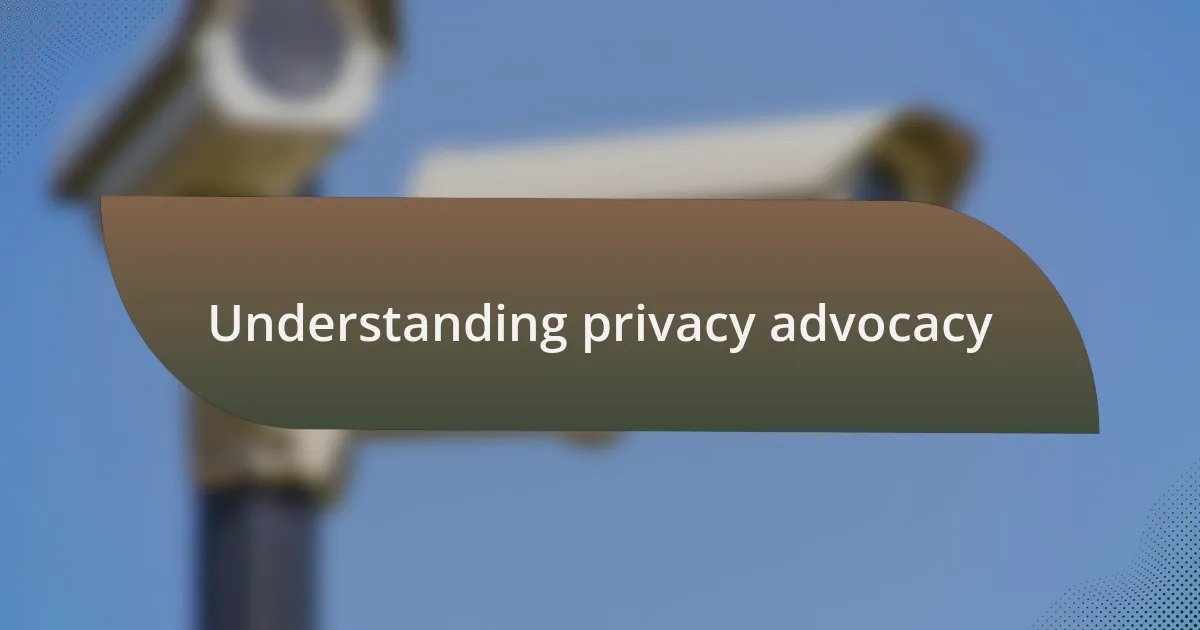
Understanding privacy advocacy
Privacy advocacy is about more than just shielding personal information; it’s fundamentally rooted in the belief that individuals have the right to control their own data. I remember a time when I stumbled upon a local initiative aiming to gather community opinions on data collection practices. It struck me how this effort fostered a sense of empowerment among residents, highlighting the importance of having a voice in privacy matters.
Consider this: why should our data be a commodity for corporations without our consent? This question often weighs on my mind when I see the growing trend of surveillance and data mining. I’ve personally experienced the discomfort of realizing how much my online habits are tracked, making me more aware of the necessity of advocacy that promotes transparency and accountability from those who handle sensitive information.
Understanding privacy advocacy also means recognizing the nuances of local ordinances that shape data protection at the community level. I recall attending a town hall meeting where local officials discussed new legislation aimed at protecting consumer data. It was enlightening to see how grassroots efforts can influence policy, reinforcing my belief that effective advocacy is both a collective and personal journey. Together, we can challenge the status quo and demand respect for our privacy rights.
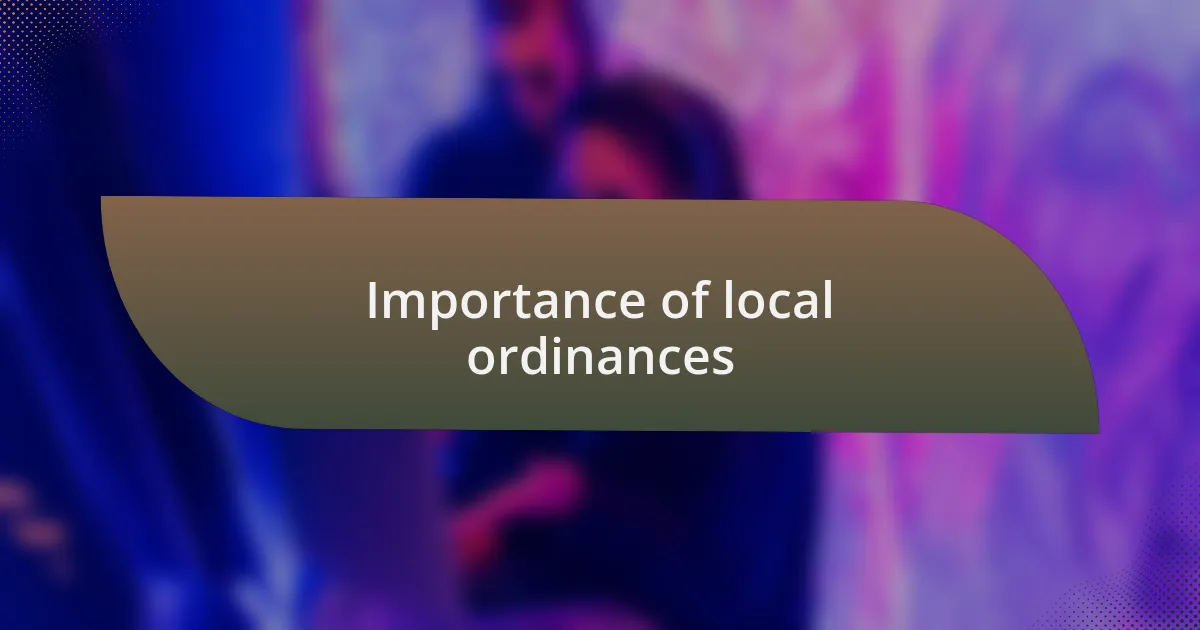
Importance of local ordinances
Local ordinances play a critical role in shaping privacy protections within communities. For me, witnessing the passage of a local ordinance that prohibited the sale of location data without consent was a proud moment. It felt empowering to see a community stand together to affirm the value of personal privacy and take action against invasive practices.
I often think about how local ordinances can create tailored solutions that reflect the unique values and concerns of a community. For instance, when my neighborhood implemented stricter regulations on surveillance in public spaces, it made me feel safer and more respected as a resident. This localized approach often facilitates a dialogue between citizens and local governments, allowing for adjustments based on direct feedback from those affected.
Moreover, the impact of local ordinances often extends beyond their borders, inspiring other regions to adopt similar measures. I remember attending a conference where representatives from small towns shared their experiences of pushing back against large tech companies through local laws. Listening to their stories instilled a sense of hope in me—a reminder that even small communities can challenge the overarching narratives of privacy violation and push for meaningful change.
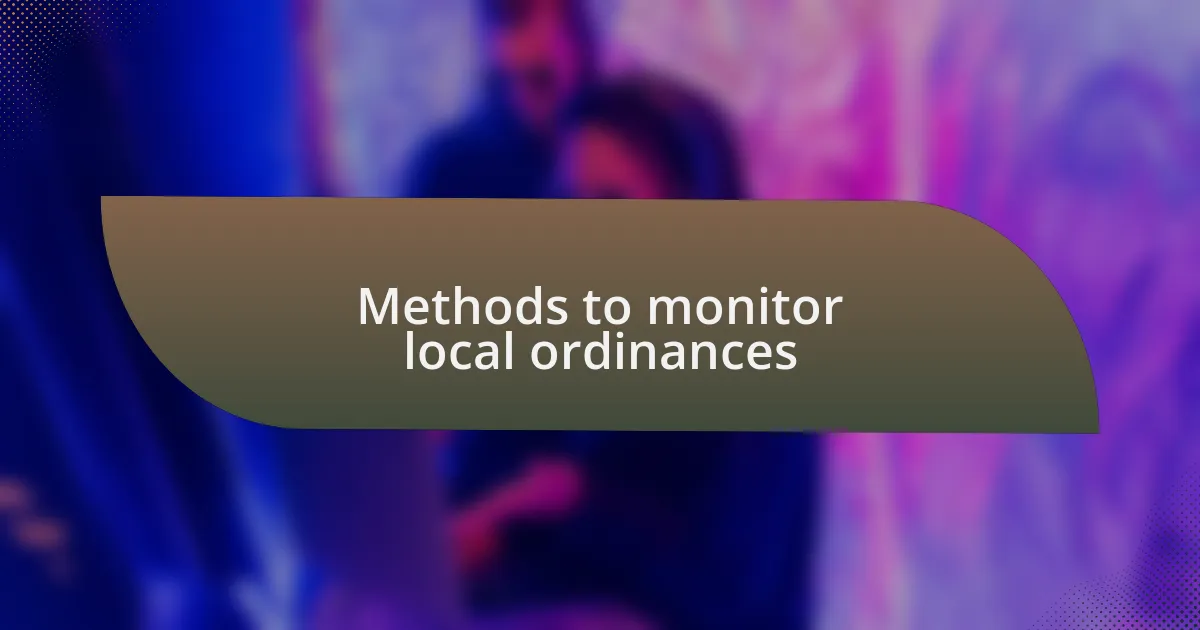
Methods to monitor local ordinances
Monitoring local ordinances can be done effectively through several engaging methods. One of my preferred strategies is subscribing to local government websites and newsletters. I recall the excitement of receiving updates about upcoming hearings; it felt like having a front-row seat to the decision-making process. How many people take the time to do this, I wonder? For me, it transformed the way I perceived local governance.
Another effective approach is to engage with community groups dedicated to privacy advocacy. I remember my first meeting with such a group—being surrounded by like-minded individuals made me realize the power of collective action. We often discuss pending ordinances, share insights, and brainstorm ways to mobilize the community. It’s invigorating to think that every conversation can spark change.
Lastly, attending local council meetings provides an unparalleled opportunity to witness the process in action. When I first walked into a council meeting, I was amazed at how transparent it was and how passionate the speakers were about their topics. It was not just about ordinances but about the voices of the people. It’s a vivid reminder that every voice counts, don’t you think?
![]()
Tools for tracking ordinances
To track local ordinances effectively, utilizing online databases like Municode can be a game changer. I remember the first time I navigated through the vast repository of municipal codes and felt empowered by the sheer amount of information at my fingertips. It sparked my curiosity—why aren’t more people aware of these tools that put legislative documents right at our disposal?
Another handy resource I’ve found is using social media platforms. I often set up alerts for specific topics or hashtags related to local regulations. It’s fascinating to see how communities engage in discussions, and I sometimes find trends in public sentiment that can influence upcoming ordinances. Have you ever noticed how social media can amplify voices and bring local issues to the forefront?
Lastly, collaborating with data visualization tools like city dashboards presents an innovative way to track changes over time. I once created a simple chart to display the frequency of ordinance updates, and it really opened my eyes to patterns I hadn’t noticed before. How powerful it is to see data come to life! These tools not only enhance understanding but also foster a proactive stance on advocacy.
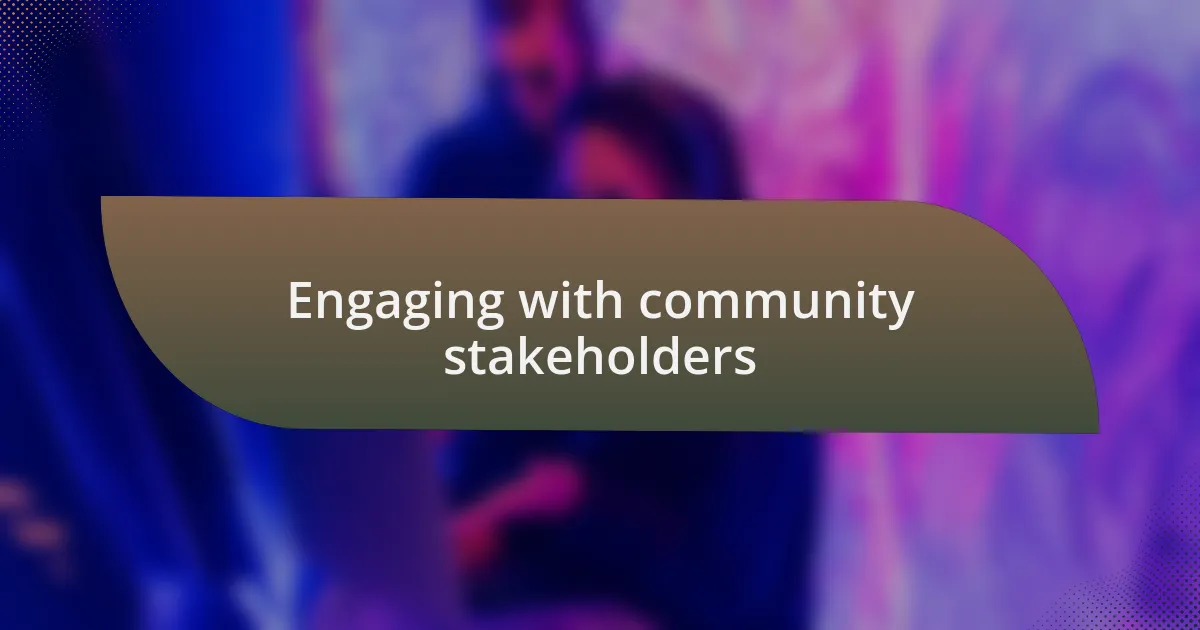
Engaging with community stakeholders
Engaging with community stakeholders is essential for effective advocacy. I’ve experienced firsthand how attending town hall meetings and local forums can provide valuable insights. The energy in those rooms is palpable; people are passionate about their neighborhoods. Have you ever thought about how much local leaders value personal interactions? They respond in ways that surveys just can’t capture.
Building relationships with local organizations is another key strategy. I recall partnering with a neighborhood association to discuss updating privacy ordinances. It was remarkable to witness how collaborating with them not only amplified our message but fostered a genuine sense of community. Isn’t it interesting how shared goals can create strong connections and ultimately lead to more effective advocacy?
Finally, I often find that informal discussions in community spaces—like coffee shops or local parks—can yield surprising insights. One afternoon, I overheard a conversation about a proposed ordinance, prompting me to join in and share my perspective. The dialogue that ensued was enlightening, highlighting concerns I hadn’t considered. Have you ever had a casual chat that shifted your understanding of local issues? The informal setting encouraged openness, showcasing the power of grassroots engagement.
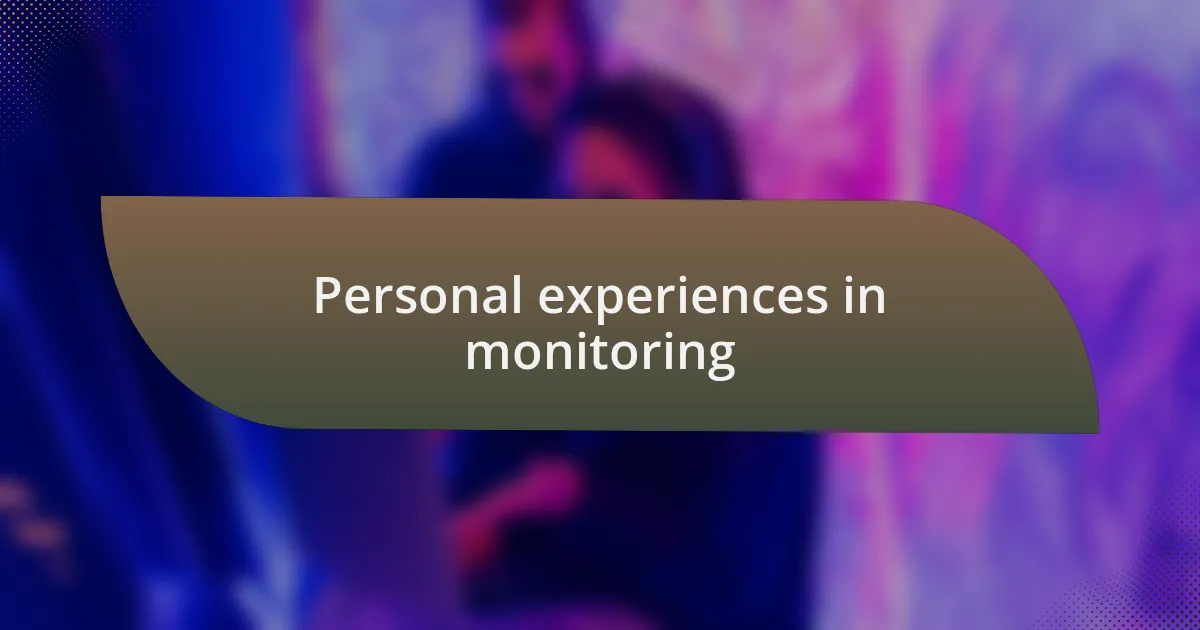
Personal experiences in monitoring
Monitoring local ordinances is not just a task; it’s about building a connection with the community. One evening, while reviewing minutes from a city council meeting, I found an overlooked clause that could have serious implications for personal data usage. The sense of responsibility that washed over me was profound. Have you ever felt the weight of what you discovered suddenly shifting your perspective on a local policy?
Another time, I set up alerts for specific keywords related to privacy ordinances, which allowed me to catch updates as they happened. I vividly remember receiving a notification late one night; it was an unexpected proposal that needed immediate response. I spent hours drafting an email to local officials, urging them to reconsider the implications of the new regulation. It was exhausting, but knowing my input could influence local privacy protections kept me energized. Have you ever had a late-night revelation that compelled you to act?
Engaging with local media was another aspect of my monitoring experience that truly opened my eyes. I reached out to a journalist covering privacy issues, sharing insights from my research. The conversation was dynamic and insightful—her questions challenged my assumptions and led to a deeper understanding of the narrative being shaped in the news. Within a week, I saw our discussions unfold in an article, raising awareness among countless residents. Isn’t it fascinating how a simple conversation can turn into a catalyst for meaningful change?
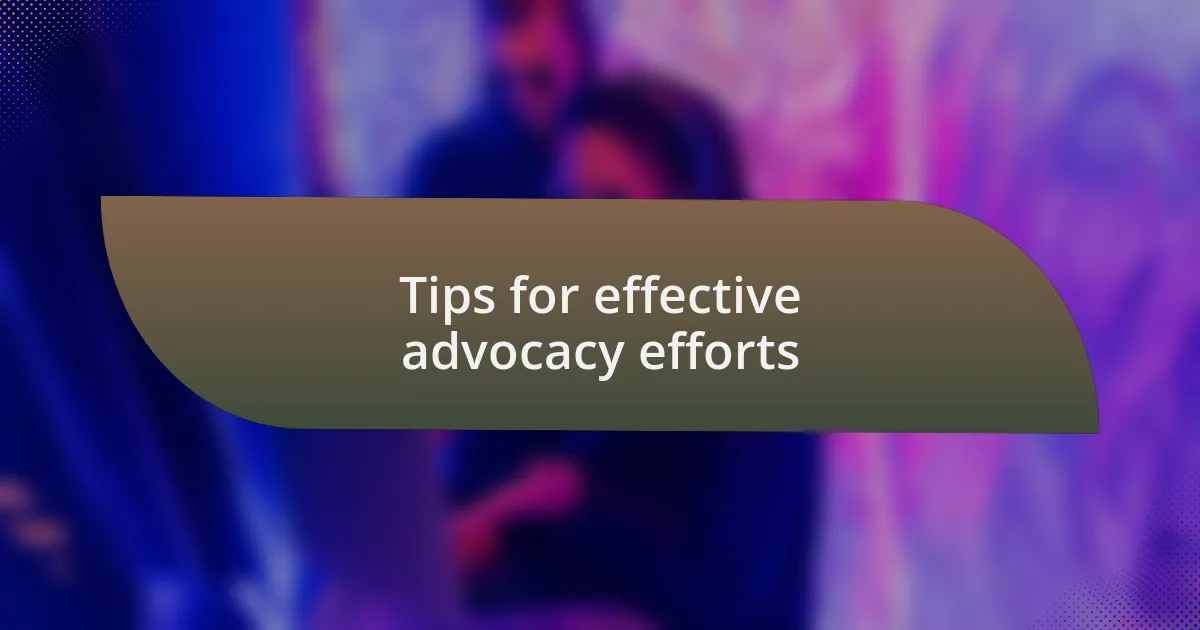
Tips for effective advocacy efforts
When advocating for privacy, always ground your efforts in accurate information. I remember a time I joined a community meeting that initially felt overwhelming due to the technical jargon thrown around. But as I took the time to thoroughly research the topics discussed, I was able to contribute meaningfully to the conversation, clarifying misconceptions about data usage. Don’t you think it’s empowering to turn complex issues into understandable concepts?
Building relationships with fellow advocates can significantly amplify your voice. I once attended a small workshop where I met a passionate group of individuals dedicated to privacy rights. We shared our experiences and strategized together, which not only enriched my understanding but also fostered a support network. Isn’t it interesting how collaboration can transform solitary efforts into collective power?
Utilizing social media for outreach can also be a game changer. I started using platforms to share updates about local ordinances and engaged with followers on privacy concerns. It was gratifying to see the conversation grow, as people began to voice their opinions and share my posts. Have you found that one social media interaction can spark a greater awareness and mobilize community action?